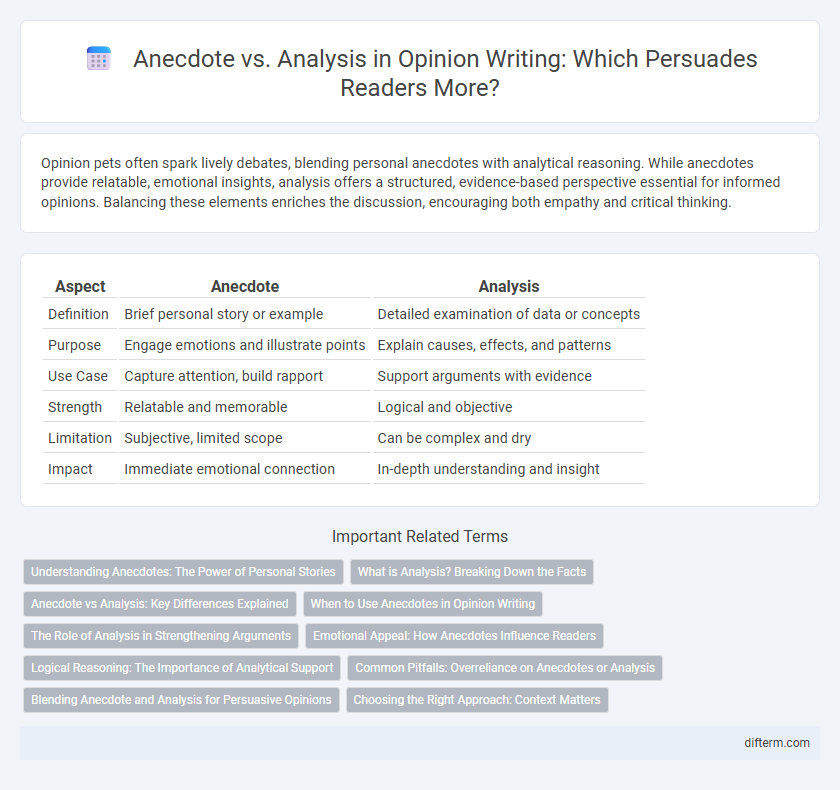Opinion pets often spark lively debates, blending personal anecdotes with analytical reasoning. While anecdotes provide relatable, emotional insights, analysis offers a structured, evidence-based perspective essential for informed opinions. Balancing these elements enriches the discussion, encouraging both empathy and critical thinking.
Table of Comparison
| Aspect | Anecdote | Analysis |
|---|---|---|
| Definition | Brief personal story or example | Detailed examination of data or concepts |
| Purpose | Engage emotions and illustrate points | Explain causes, effects, and patterns |
| Use Case | Capture attention, build rapport | Support arguments with evidence |
| Strength | Relatable and memorable | Logical and objective |
| Limitation | Subjective, limited scope | Can be complex and dry |
| Impact | Immediate emotional connection | In-depth understanding and insight |
Understanding Anecdotes: The Power of Personal Stories
Anecdotes capture attention by providing relatable, vivid examples that evoke emotions and make complex ideas more accessible. Personal stories create a strong connection between the storyteller and the audience, enhancing retention and persuasion through authentic experience. This emotional engagement often makes anecdotes more memorable than abstract analysis, underscoring their power in communication and learning.
What is Analysis? Breaking Down the Facts
Analysis involves systematically breaking down information into core components to understand relationships, patterns, and underlying causes. It prioritizes objective evaluation of data over personal interpretation or storytelling found in anecdotes. By dissecting facts and evidence, analysis enables informed decision-making and deeper insight into complex issues.
Anecdote vs Analysis: Key Differences Explained
Anecdotes provide vivid, personal stories that engage emotions and offer relatable insights, while analysis delivers structured, evidence-based evaluations that clarify complex information. Anecdotal evidence can enhance narratives but lacks the rigorous validation found in analytical approaches. Understanding these distinctions helps in choosing the right method to convey opinion effectively.
When to Use Anecdotes in Opinion Writing
Use anecdotes in opinion writing to create emotional connections and illustrate personal experiences that support the argument. They are most effective when aiming to engage readers or highlight a unique perspective that statistical analysis alone cannot convey. Balance anecdotes with factual evidence to maintain credibility while enhancing reader empathy.
The Role of Analysis in Strengthening Arguments
Anecdotes provide relatable examples that capture attention, but analysis adds depth by interpreting evidence and connecting it to broader concepts, thereby enhancing the credibility of an argument. Incorporating analytical frameworks and data-driven insights transforms subjective narratives into persuasive, well-substantiated claims. Effective arguments rely on analysis to critically evaluate information, identify patterns, and support conclusions with logical reasoning.
Emotional Appeal: How Anecdotes Influence Readers
Anecdotes evoke strong emotional responses by painting vivid, relatable scenarios that connect readers to the narrative on a personal level. Unlike abstract analysis, these compelling stories activate empathy and memory, making arguments more memorable and persuasive. Emotional appeal through anecdotes enhances reader engagement by transforming information into impactful, human-centered experiences.
Logical Reasoning: The Importance of Analytical Support
Anecdotes often appeal to emotions but lack the rigor essential for sound logical reasoning in opinion formation. Analytical support provides structured evidence and critical evaluation, ensuring arguments are valid and reliable. Emphasizing data-driven analysis over personal stories strengthens the credibility and persuasiveness of any opinion.
Common Pitfalls: Overreliance on Anecdotes or Analysis
Relying too heavily on anecdotes can lead to biased or unrepresentative conclusions that lack empirical support, while excessive dependence on analysis may overlook the human element and contextual nuances. Effective judgment requires balancing concrete data with real-world experiences to avoid misinterpretation or oversimplification. Recognizing these pitfalls enhances critical thinking and strengthens the validity of opinions.
Blending Anecdote and Analysis for Persuasive Opinions
Blending anecdote and analysis enriches persuasive opinions by combining emotional resonance with logical reasoning, creating a compelling narrative that engages readers on multiple levels. Anecdotes provide relatable, concrete examples that humanize abstract concepts, while analysis offers critical insights and evidence that validate the viewpoint. This strategic fusion enhances credibility and memorability, making arguments more effective and influential in shaping audience perceptions.
Choosing the Right Approach: Context Matters
Selecting between anecdote and analysis hinges on the context and purpose of communication, as anecdotes offer relatable, memorable experiences while analysis delivers structured, data-driven insights. In persuasive writing or presentations, anecdotes can engage emotions and create a personal connection, making complex concepts accessible. However, in academic or technical settings, thorough analysis ensures credibility, supporting decisions with evidence and logical reasoning fundamental to informed conclusions.
anecdote vs analysis Infographic

 difterm.com
difterm.com